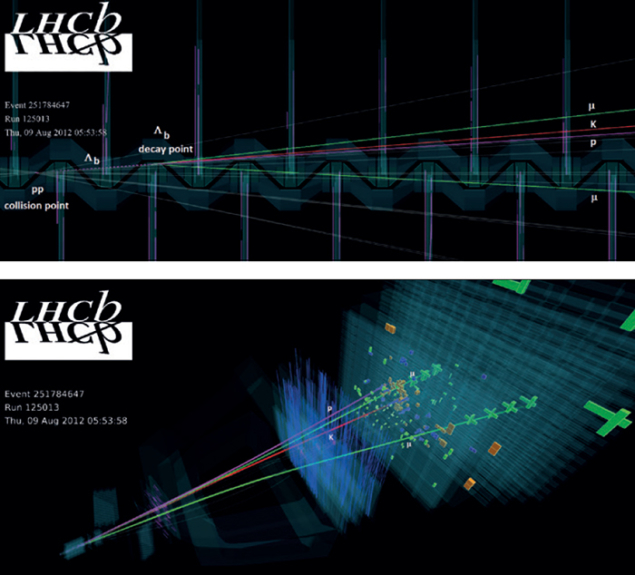
In 1964, Murray Gell-Mann and George Zweig independently predicted a substructure for hadrons: baryons would be comprised of three quarks, mesons of a quark–antiquark pair. They also said that baryons with four quarks and one antiquark were possible, as were mesons with two quarks and two antiquarks – dubbed, respectively, pentaquarks and tetraquarks, after the number of constituents. Since then, the picture for baryons and mesons has been thoroughly established within QCD, the theory of the strong interaction. Claims of the sighting of pentaquarks, meanwhile, have been thoroughly debunked. Nevertheless, their existence could cast important new light on QCD.

Now, the LHCb collaboration has announced the observation of two pentaquark states, P+c, in analysis of data collected during Run 1 of the LHC at CERN. The discovery was made during the analysis of the decay Λb → J/ψ K– p, a decay mode used in the precision measurement of the Λb lifetime (CERN Courier July/August 2013 p8). There was, however, an apparent anomaly in the pattern of these decays. The Dalitz plot, in which only 5.4% is background, shows several expected Λ* → K– p resonances as vertical bands, but there is also a horizontal band, indicative of a resonance decaying into J/ψ p, which was completely unexpected (figure 1).

A resonance decaying into J/ψ p would be a pentaquark state (with quarks uudcc). So LHCb investigated more deeply, with a full six-dimensional amplitude analysis of the two interfering decay sequences: Λb → J/ψ Λ*, Λ* → K– p, and Λb → P+c K–, P+c → J/ψ p. This analysis not only fit the invariant mass of the decay products, the angular distributions for the decays were also fit, along with the invariant mass – this was not a simple “bump hunt”.
The first attempt was to fit the data without any P+c states, with the belief that the structure could be built up from Λ* interferences. This failed. The next attempt was with one P+c state, but the fit was deficient. Finally, a fit with two P+c states proved to be acceptable. The masses of the states are 4380±8±29 MeV and 4449.8±1.7±2.5 MeV, with widths of 205±18±86 MeV and 39±5±19 MeV, respectively. The states have opposite parities, with one state having spin 3/2 and the other spin 5/2. The final fitted J/ψ p mass spectra show the two states (figure 2). The significances of each state are more than 9σ.
LHCb has subjected the results to a great many systematic checks. These include ensuring that tracks were not “clones” or “ghosts”, splitting the data into different subsets, such as Λb versus Λb, data from 2011 versus 2012, magnetic field up versus down, etc. All of these tests have been passed.
One interesting fact is that these pentaquarks decay into J/ψ, as do candidate states for tetraquark mesons (CERN Courier June 2014 p12). This suggests that two heavy quarks may be needed to provide the binding for these exotic states.








